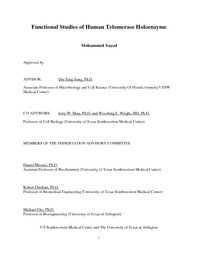
ATTENTION: The works hosted here are being migrated to a new repository that will consolidate resources, improve discoverability, and better show UTA's research impact on the global community. We will update authors as the migration progresses. Please see MavMatrix for more information.
Show simple item record
| dc.creator | Sayed, Mohammed E. | |
| dc.date.accessioned | 2016-10-25T20:38:57Z | |
| dc.date.available | 2016-10-25T20:38:57Z | |
| dc.date.created | 2016-08 | |
| dc.date.issued | 2016-09-13 | |
| dc.date.submitted | August 2016 | |
| dc.identifier.uri | http://hdl.handle.net/10106/26170 | |
| dc.description.abstract | Telomeres are the DNA structures that cap the ends of linear chromosomes. In humans, telomeres are composed of the hexameric repeats TTAGGG. The reverse transcriptase, telomerase maintains the telomeres by adding the TTAGGG repeats to the chromosomes during cell division. In the absence of telomerase, telomere length limits the self-renewal capabilities of cells. Telomerase is expressed in approximately 90% of all human cancers, making it an almost universal therapeutic target as well as an important player in the progression from healthy to cancerous cell.
The biophysical studies discussed in this thesis focus on expanding the understanding of the function and enzymology of human telomerase. We have developed a working hypothesis that the dimeric telomerase behaves as a single-pass enzyme, which needs to be reactivated after its processive extension reaction on a substrate. We used different biochemical approaches in conjunction with a highly quantitative activity assay to test this hypothesis. We first observed that in both gel based TRAP and the digital droplet TRAP (ddTRAP) assays, telomerase exhibited catalysis-dependent inactivation. The qPCR and ddPCR analysis found that the enzyme was stable without catalysis. In sequential extension experiments, telomerase showed both fast-acting and slow-acting sites and these two types of active sites had different substrate affinities and acted in tandem. The sequential action of these two active sites required that both must be harbored by individual dimeric telomerase complexes. This suggests that the two active sites in each enzyme are asymmetrical, one fast and one slow, and after two passes of reaction, a dimeric enzyme becomes inactive. Furthermore, we discovered the potential of many cancerous and non-cancerous cell lysates with and without telomerase activity to reactivate the catalytically exhausted telomerase complexes. Taken together, the data support the single-pass hypothesis, provide a new catalytic mechanism for telomerase holoenzyme, and suggest a novel regulatory mechanism of its activity in a catalysis-dependent manner. | |
| dc.format.mimetype | application/pdf | |
| dc.language.iso | en_US | |
| dc.subject | Telomerase | |
| dc.subject | Cancer | |
| dc.subject | Biomedical engineering | |
| dc.subject | Bioengineering | |
| dc.subject | Aging | |
| dc.subject | Functional | |
| dc.title | Functional Studies of the Human Telomerase Holoenzyme | |
| dc.type | Thesis | |
| dc.degree.department | Bioengineering | |
| dc.degree.name | Doctor of Philosophy in Biomedical Engineering | |
| dc.date.updated | 2016-10-25T20:41:04Z | |
| thesis.degree.department | Bioengineering | |
| thesis.degree.grantor | The University of Texas at Arlington | |
| thesis.degree.level | Doctoral | |
| thesis.degree.name | Doctor of Philosophy in Biomedical Engineering | |
| dc.type.material | text | |
Files in this item
- Name:
- SAYED-DISSERTATION-2016.pdf
- Size:
- 3.436Mb
- Format:
- PDF
This item appears in the following Collection(s)
Show simple item record


